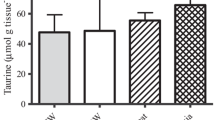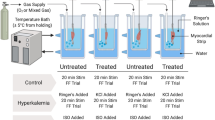Abstract
Taurine is the most abundant amino acid in the blood of the cuttlefish, Sepia officinalis, where levels can exceed 200 mmol L−1. In mammals, intracellular taurine modulates cardiac Ca2+ handling and carbohydrate metabolism at much lower concentrations but it is not clear if it exerts similar actions in cephalopods. Blood Ca2+ levels are high in cephalopods and we hypothesized that taurine would depress cardiac Ca2+ flux and modulate contractility in systemic and branchial hearts of cuttlefish. Heart performance was assessed with an in situ perfused systemic heart preparation and contractility was evaluated using isometrically contracting systemic and branchial heart muscle rings. Stroke volume, cardiac output, and Ca2+ sensitivity were significantly lower in systemic hearts perfused with supplemental taurine (100 mmol L−1) than in controls. In muscle ring preparations, taurine impaired relaxation at high contraction frequencies, an effect abolished by supra-physiological Ca2+ levels. Taurine did not affect oxygen consumption in non-contracting systemic heart muscle, but extracellular glucose utilization was twice that of control preparations. Collectively, our results suggest that extracellular taurine depresses cardiac Ca2+ flux and potentiates glucose utilization in cuttlefish. Variations in taurine levels may represent an important mechanism for regulating cardiovascular function and metabolism in cephalopods.







Similar content being viewed by others
References
Agnisola C, Houlihan DF (1991) Oxygen supply and in vitro performance of the systemic heart of Octopus vulgaris: effects of haemocyanin. J Exp Biol 157:523–541
Altimiras J, Hove-Madsen L, Gesser H (1999) Ca2+ uptake in the sarcoplasmic reticulum from the systemic heart of octopod cephalopods. J Exp Biol 202:2531–2537
Ballantyne IS, Hochachka PW, Mommsen TP (1981) Studies on the metabolism of the migratory squid, Loligo opalescens: enzymes of tissues and heart mitochondria. Mar Biol Lett 2:75–85
Bergmeyer HU, Gawehn K, Grassl M (1974) Enzymes as biochemical reagents. In: Bergmeyer HU (ed) Methods of enzymatic analysis, vol 1. Academic Press, New York, pp 425–522
Bourne GB (1982) Blood pressure in the squid, Loligo pealei. Comp Biochem Physiol 72A:23–27
De la Puerta C, Arrieta FJ, Balsa JA, Botella-Carretero JI, Zamarrón I, Vázquez C (2010) Taurine and glucose metabolism: a review. Nutr Hosp 25:910–919
Devlin CL (1993a) An analysis of control of the ventricle of the mollusc Mercenaria mercenaria. I. The ionic basis of autorhythmicity. J Exp Biol 179:47–61
Devlin CL (1993b) An analysis of control of the ventricle of the mollusc Mercenaria mercenaria. II. Ionic mechanisms involved in excitation by 5-hydroxytryptamine. J Exp Biol 179:63–75
Dieni CA, Callaghan NI, Gormley PT, Butler KMA, MacCormack TJ (2014) Physiological hepatic response to zinc oxide nanoparticle exposure in the white sucker, Catostomus commersonii. Comp Biochem Physiol 162C:51–61
Driedzic WR (1985) Contractile performance of cephalopod hearts under anoxic conditions. J Exp Biol 117:471–474
Driedzic WR, Sidell BD, Stewart JM, Johnston IA (1990) Maximal activities of enzymes of energy metabolism in cephalopod systemic and branchial hearts. Physiol Zool 63:615–629
Foti L, Genoino IT, Agnisola G (1985) In vitro cardiac performance in Octopus vulgaris (Lam). Comp Biochem Physiol 82C:483–488
Franconi F, Martini F, Stendardi I, Matucci R, Zilletti L, Giotti A (1982) Effect of taurine on calcium levels and contractility in guinea-pig ventricular strips. Biochem Pharmacol 31:3181–3185
Gesser H, Driedzic WR, Rantin FT, de Freitas JC (1997) Ca2+ regulation of heart contractility in Octopus. J Comp Physiol B 167:474–480
Gutowska MA, Melzner F, Langenbuch M, Bock C, Claireaux G, Pörtner H-O (2010) Acid–base regulatory ability of the cephalopod (Sepia officinalis) in response to environmental hypercapnia. J Comp Physiol B 180:323–335
Hochachka PW, Mommsen TP, Storey J, Storey KB, Johansen K, French CJ (1983) The relationship between arginine and proline metabolism in cephalopods. Mar Biol Lett 4:1–21
Hoeger U, Mommsen TP (1985) Role of free amino acids in the oxidative metabolism of cephalopod hearts. In: Gilles R (ed) Circulation, respiration, and metabolism. Current comparative approaches. Springer, Berlin, pp 367–376
Houlihan DF, Agnisola C, Hamilton NM, Genoino IT (1987) Oxygen consumption of the isolated heart of Octopus: effects of power output and hypoxia. J Exp Biol 131:137–157
Huxtable RJ (1992) Physiological actions of taurine. Physiol Rev 72:101–163
Imae M, Asano T, Murakami S (2014) Potential role of taurine in the prevention of diabetes and metabolic syndrome. Amino Acids 46:81–88
Johansen K, Martin AW (1962) Circulation in the cephalopod, Octopus dofleini. Comp Biochem Physiol 5:161–176
King AJ, Adamo SA (2006) The ventilatory, cardiac and behavioural responses of resting cuttlefish (Sepia officinalis L.) to sudden visual stimuli. J Exp Biol 209:1101–1111
Kling G, Schipp R (1987) Comparative ultrastructural and cytochemical analysis of the cephalopod systemic heart and its innervation. Experientia 43:502–511
Lamarre SG, Ditlecadet D, McKenzie DJ, Bonnaud L, Driedzic WR (2012) Mechanisms of protein degradation in mantle muscle and proposed gill remodeling in starved Sepia officinalis. Am J Physiol 303:R427–R437
Lampson WG, Kramer JH, Schaffer SW (1983) Potentiation of the actions of insulin by taurine. Can J Physiol Pharmacol 61:457–463
Lewbart GA (2006) Invertebrate medicine. Blackwell Publishing, Ames, p 356
Maturo J, Kulakowski EC (1988) Taurine binding to the purified insulin receptor. Biochem Pharmacol 37:3755–3760
Melzner F, Bock C, Pörtner H-O (2007) Coordination between ventilatory pressure oscillations and venous return in the cephalopod Sepia officinalis under control conditions, spontaneous exercise and recovery. J Comp Physiol B 177:1–17
Mommsen TP, Hochachka PW (1981) Respiratory and enzymatic properties of squid heart mitochondria. Eur J Biochem 120:345–350
O’Dor RK, Webber DM (1986) The constraints on cephalopods: why squid aren’t fish. Can J Zool 64:1591–1605
Ott M, Gogvadze V, Orrenius S, Zhivotovsky B (2007) Mitochondria, oxidative stress and cell death. Apoptosis 12:913–922
Öz E, Erbaş D, Gelir E, Arıcıoğlu A (1999) Taurine and calcium interaction in protection of myocardium exposed to ischemic reperfusion injury. Gen Pharmacol 33:137–141
Pertseva MN, Shpakov AO, Plesneva SA, Kuznetsova LA (2003) A novel view on the mechanisms of action of insulin and other insulin superfamily peptides: involvement of adenylyl cyclase signaling system. Comp Biochem Physiol 134B:11–36
Robertson JD (1953) Further studies on ionic regulation in marine invertebrates. J Exp Biol 30:277–296
Satoh H (1994) Cardioprotective actions of taurine against intracellular and extracellular calcium-induced effects. In: Huxtable RJ, Michalk D (eds) Taurine in health and disease. Springer Science + Business Media, New York, pp 181–196
Satoh H, Nakatani T, Tanaka T, Haga S (2002) Cardiac functions and taurine’s actions at different extracellular calcium concentrations in forced swimming stress-loaded rats. Biol Trace Element Res 87:171–182
Schaffer SW, Jong CJ, Ramila KC, Azuma J (2010) Physiological roles of taurine in heart and muscle. J Biomed Sci 17(Suppl 1):S2
Schaffer SW, Jong CJ, Ito T, Azuma J (2014) Effect of taurine on ischemia–reperfusion injury. Amino Acids 46:21–30
Shaffer J, Kocsis J (1981) Taurine mobilizing effects of beta alanine and other inhibitors of taurine transport. Life Sci 28:2727–2736
Shiels HA, White E (2008) The Frank-Starling mechanism in vertebrate cardiac myocytes. J Exp Biol 211:2005–2013
Smith PJS (1981) The role of venous pressure in regulation of output from the heart of the octopus, Eledone cirrhosa (Lam.). J Exp Biol 93:243–255
Storey KB, Storey JM, Johansen K, Hochachka PW (1979) Octopine metabolism in Sepia officinalis: effect of hypoxia and metabolite load on the blood levels of octopine and related compounds. Can J Zool 57:2331–2336
Sykes AV, Domingues PM, Andrade JP (2014) European cuttlefish, Sepia officinalis. In: Iglesias J, Fuentes L, Villanueva R (eds) Cephalopod culture. Springer, Netherlands, pp 175–204
Vislie T (1983) Cell volume regulation in fish heart ventricles with special reference to taurine. Comp Biochem Physiol 76A:507–514
Wells MJ (1979) The heartbeat of Octopus vulgaris. J Exp Biol 78:87–104
Wells MJ (1980) Nervous control of the heartbeat in Octopus. J Exp Biol 85:111–128
Wells MJ, Wells J (1983) The circulatory response to acute hypoxia in Octopus. J Exp Biol 104:59–71
Zhao X, Jia J, Lin Y (1998) Taurine content in Chinese food and daily taurine intake of Chinese men. In: Schaffer S, Lombardini JB, Huxtable RJ (eds) Taurine 3: cellular and regulatory mechanisms. Springer Science + Business Media, New York, pp 501–505
Acknowledgments
The authors thank Dr. Juan Fuentes, Mr. João Reis and the students and staff at Ramalhete Station for valuable input and logistical assistance with the study. TJM and WRD were supported by Natural Sciences and Engineering Research Council of Canada (NSERC) Discovery grants. WRD holds the Canada Research Chair in Marine Bioscience. AVS was supported by Fundação para a Ciência e a Tecnologia through Programa Investigador FCT 2014 (IF/00576/2014) and project SEPIATECH (31-03-05-FEP-2) funded by the Portuguese Government Program PROMAR. NIC was supported by an NSERC CGS-M award and a New Brunswick Innovation Foundation graduate fellowship.
Author information
Authors and Affiliations
Corresponding author
Additional information
Communicated by G. Heldmaier.
Rights and permissions
About this article
Cite this article
MacCormack, T.J., Callaghan, N.I., Sykes, A.V. et al. Taurine depresses cardiac contractility and enhances systemic heart glucose utilization in the cuttlefish, Sepia officinalis . J Comp Physiol B 186, 215–227 (2016). https://doi.org/10.1007/s00360-015-0946-0
Received:
Revised:
Accepted:
Published:
Issue Date:
DOI: https://doi.org/10.1007/s00360-015-0946-0




